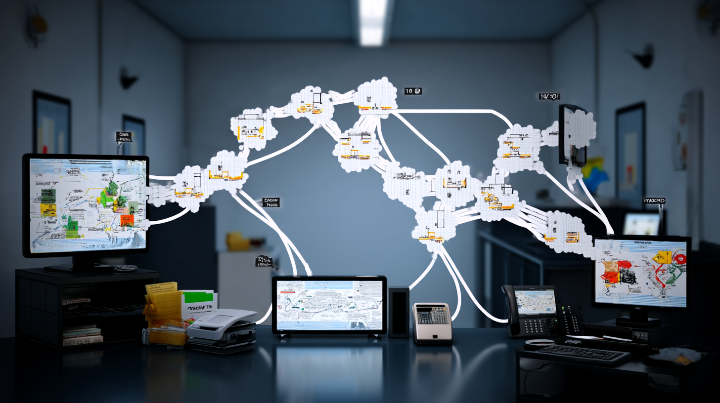From Wires to Wireless: The Evolution of Business Phone Systems
A Journey Through Telegraph Lines, Rotary Dials, and Modern Pro Mobile VoIP Solutions
Business telephone systems have dramatically evolved over the decades, continuously reshaping how businesses communicate internally and externally. This detailed exploration highlights key advancements, making complex technological innovations relatable and understandable for everyone.
Telegraph to Telephone: Connecting with Voices (Mid-1800s)
The story of business communication began with the invention of the telegraph in the 1830s. Telegraphy used Morse code—dots and dashes—to transmit messages across distances. It was revolutionary, significantly improving the speed of information exchange over traditional mail services. However, true conversational communication began with Alexander Graham Bell’s invention of the telephone in 1876. This landmark achievement allowed for immediate voice interactions, significantly enhancing business productivity and efficiency by enabling quicker decision-making and real-time discussions.
The adoption of telephones was gradual due to initial infrastructure limitations and high costs. Early adopters, primarily large businesses and government institutions, saw immediate improvements in productivity and operational effectiveness. Smaller businesses soon followed, recognizing the clear competitive advantage provided by telephone communication.

The Switchboard Era: Human Connection (Late 1800s – Early 1900s)
Initially, all business calls required the intervention of telephone operators who manually connected each call using a physical switchboard. Picture calling your colleague and having to wait patiently while an operator physically linked your lines by plugging wires into a panel. Despite seeming cumbersome today, this approach was groundbreaking at the time, dramatically increasing the accessibility and reach of businesses.
Switchboards became increasingly sophisticated, and operators became adept at managing multiple calls simultaneously, efficiently routing important conversations. This manual system laid essential groundwork for future automated technologies and was a critical step toward the streamlined communications we rely on today.

Automation with Rotary Phones (1920s – 1950s)
The introduction of automatic switching technology marked another transformative shift in telephone communications. By eliminating the need for manual operators, call connection times dropped dramatically. Rotary dial telephones emerged, enabling users to dial numbers directly. This development brought unprecedented convenience and autonomy to businesses.
During this period, rotary phones became symbols of modernity in offices worldwide. Businesses enjoyed newfound speed in reaching clients and colleagues, enhancing internal coordination and customer satisfaction.

Touch-Tone and PBX: Enhanced Call Management (1960s – 1980s)
The next major leap in business communication came with the introduction of touch-tone telephones and Private Branch Exchange (PBX) systems. Touch-tone dialing replaced rotary dials, significantly speeding up the dialing process and allowing integration with automated systems. PBX systems offered businesses the ability to route and manage multiple phone lines through a single exchange, enhancing internal communication.
These systems introduced automated voice menus and extensions, allowing customers and employees to directly reach the appropriate departments without intermediary assistance. This marked the beginning of sophisticated call management, drastically improving the efficiency of business operations.

Digital Integration and Clearer Communication (1980s – 1990s)
Advancements continued with digital PBX systems and Integrated Services Digital Network (ISDN) technology, greatly enhancing call clarity and reliability. Digital systems allowed seamless integration between telephone networks and computers, enabling features like caller identification, voicemail, and fax transmission.
This period saw businesses increasingly integrate phone systems with emerging computer technologies, paving the way for unified communications that would define future developments. Businesses began leveraging digital integration to streamline operations, reduce overhead costs, and improve customer interactions.

VoIP: Internet-Based Communication Revolution (2000s – 2010s)
The advent of Voice over Internet Protocol (VoIP) technology transformed business communications by allowing voice calls to be transmitted via the internet instead of traditional telephone lines. VoIP drastically cut costs, especially for long-distance and international communications, making it ideal for globally dispersed businesses.
Features such as voicemail-to-email, video conferencing, and automatic call routing became standard, greatly improving flexibility and efficiency. Businesses enjoyed enhanced scalability, simplified infrastructure, and the ability to rapidly deploy new communication solutions.

Pro Mobile VoIP: Ultimate Flexibility (2010s – Present)
Today, business communications have reached their pinnacle with advanced solutions such as Pro Mobile VoIP. Pro Mobile VoIP integrates traditional VoIP benefits with cellular networks, enabling businesses to leverage mobile devices seamlessly. Imagine having both personal and business lines clearly separated but conveniently accessible on a single device.
Pro Mobile VoIP solutions offer advanced features like dual SIM and eSIM capabilities, sophisticated call routing, cloud-based management, and integration with productivity applications. This ensures maximum mobility, allowing employees to stay connected regardless of their physical location—perfectly suited for remote or hybrid work environments.

Looking Ahead: Future Trends
The future promises further integration with artificial intelligence (AI), machine learning, and augmented reality (AR), delivering even more powerful communication tools. Predictive analytics, smart call routing based on customer preferences, and enhanced security measures will further streamline business communications, keeping organizations competitive and responsive.

Conclusion
From telegraph wires to wireless Pro Mobile VoIP solutions, the evolution of business telephone systems underscores a continual drive for innovation. Businesses today enjoy seamless, efficient communication tools that enhance productivity, flexibility, and connectivity, essential for navigating an ever-changing business landscape.